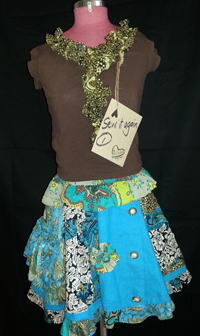 We are sweltering in Queensland again and seeking ways to keep cool, so this offering is light and breezy – and easy.
We are sweltering in Queensland again and seeking ways to keep cool, so this offering is light and breezy – and easy.
Everything I’m making during this Sew it Again year is upcycled – even my display dummy was bought from an op shop. Older things are often better quality, they were made to last. That’s part of their attraction.
I’m going on this journey in 2014 in response to the excessive consumption that is all around us – the push for more, more, more, bigger, brighter, bolder – driven by those with a vested interest.
A new year is a chance to reflect on different ways of being. And it is gratifying to find others doing similar things: people such as the amazingly creative Melbourne-based Pip Lincolne who made A Year of Ethical Fashion pledge for 2014.
Pip’s pledge for 2014 is that when looking for things to wear, she will only:
a) Buy from ethical makers or
b) Buy second-hand or
c) Make it myself or
d) Wear things I already own or
e) Borrow or swap garments with friends
I’m proud to be doing all of the above as I live my values of integrity, creativity, autonomy and purpose.
Today’s upcycle is for my friend Trudy Riesz, who wondered what to do with her many sarongs that are cheap and cheerful reminders of holidays past. They’re still useful for the beach or the pool, but not so useful for everyday dressing unless turned into a dress.
Cut the sarong in half across the middle. Flip one half so there is a fringe on either side, one fringe will be on the back piece and the other on the front piece, but that is barely noticeable when sewn together. Sew the two pieces together about 2/3rds of the way up each side, leaving the rest for your arm holes and a knot at the each shoulder. This sarong had a couple of marks on it, so I sewed buttons over them.






